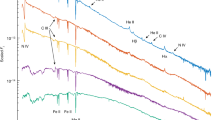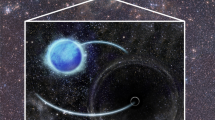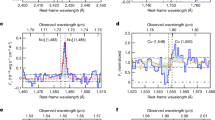Abstract
Ultraluminous X-ray sources are extragalactic objects located outside the nucleus of the host galaxy with bolometric luminosities1 exceeding 1039 erg s-1. These extreme luminosities—if the emission is isotropic and below the theoretical (Eddington) limit, where the radiation pressure is balanced by the gravitational pressure—imply the presence of an accreting black hole with a mass of ∼102–105 solar masses ( ). The existence of such intermediate-mass black holes is in dispute, and though many candidates have been proposed, none are widely accepted as definitive. Here we report the detection of a variable X-ray source with a maximum 0.2–10 keV luminosity of up to 1.1 × 1042 erg s-1 in the edge-on spiral galaxy ESO 243-49, with an implied conservative lower limit for the mass of the black hole of ∼500
). The existence of such intermediate-mass black holes is in dispute, and though many candidates have been proposed, none are widely accepted as definitive. Here we report the detection of a variable X-ray source with a maximum 0.2–10 keV luminosity of up to 1.1 × 1042 erg s-1 in the edge-on spiral galaxy ESO 243-49, with an implied conservative lower limit for the mass of the black hole of ∼500 .
.
This is a preview of subscription content, access via your institution
Access options
Subscribe to this journal
Receive 51 print issues and online access
$199.00 per year
only $3.90 per issue
Buy this article
- Purchase on Springer Link
- Instant access to full article PDF
Prices may be subject to local taxes which are calculated during checkout


Similar content being viewed by others
References
Roberts, T. P. X-ray observations of ultraluminous X-ray sources. Astrophys. Space Sci. 311, 203–212 (2007)
Miller, J. M., Fabbiano, G., Miller, M. C. & Fabian, A. C. X-ray spectroscopic evidence for intermediate-mass black holes: cool accretion disks in two ultraluminous X-ray sources. Astrophys. J. 585, L37–L40 (2003)
Casella, P. et al. Weighing the black holes in ultraluminous X-ray sources through timing. Mon. Not. R. Astron. Soc. 387, 1707–1711 (2008)
Noyola, E., Gebhardt, K. & Bergmann, M. Gemini and Hubble space telescope evidence for an intermediate-mass black hole in ω Centauri. Astrophys. J. 676, 1008–1015 (2008)
Bekki, K. & Freeman, K. C. Formation of ω Centauri from an ancient nucleated dwarf galaxy in the young Galactic disc. Mon. Not. R. Astron. Soc. 346, L11–L15 (2003)
Liu, J. & Di Stefano, R. An ultraluminous supersoft X-ray source in M81: an intermediate-mass black hole? Astrophys. J. 674, L73–L76 (2008)
King, A. R. Accretion rates and beaming in ultraluminous X-ray sources. Mon. Not. R. Astron. Soc. 385, L113–L115 (2008)
Fender, R. in Compact Stellar X-ray Sources (eds Lewin, W. & van der Klis, M.) 381–419 (Cambridge University Press, 2006)
Watson, M. G. et al. The XMM-Newton serendipitous survey. VI. The second XMM-Newton serendipitous source catalogue. Astron. Astrophys. 493, 339–373 (2009)
Afonso, J. et al. The phoenix deep survey: spectroscopic catalog. Astrophys. J. 624, 135–154 (2005)
Miniutti, G. et al. Have we detected the most luminous ULX so far? Mon. Not. R. Astron. Soc. 373, L1–L5 (2006)
Hurkett, C. P. et al. Line searches in Swift X-ray spectra. Astrophys. J. 679, 587–606 (2008)
Güdel, M. X-ray astronomy of stellar coronae. Astron. Astrophys. Rev. 12, 71–237 (2004)
Immler, S. & Lewin, W. H. G. in Supernovae and Gamma-Ray Bursters (ed. Weiller, K.) 91–111 (Springer, 2003)
Baskill, D. S., Wheatley, P. J. & Osborne, J. P. The complete set of ASCA X-ray observations of non-magnetic cataclysmic variables. Mon. Not. R. Astron. Soc. 357, 626–644 (2005)
Hilton, E. J. et al. XMM-Newton observations of the cataclysmic variable GW Librae. Astron. J. 134, 1503–1507 (2007)
Jonker, P. G. Constraining the neutron star equation of state using quiescent low-mass X-ray binaries. AIP Conf. Proc. 983, 519–526 (2008)
Done, C., Gierliński, M. & Kubota, A. Modelling the behaviour of accretion flows in X-ray binaries. Astron. Astrophys. Rev. 15, 1–66 (2007)
Giommi, P. et al. in Blazar Astrophysics with BeppoSAX and Other Observatories (eds Giommi, P., Massaro, E. & Palumbo, G.) 63–99 (ESA-ESRIN, 2002)
Turriziani, S., Cavazzuti, E. & Giommi, P. ROXA: a new multi-frequency large sample of blazars selected with SDSS and 2dF optical spectroscopy. Astron. Astrophys. 472, 669–704 (2007)
Berghea, C. T., Weaver, K. A., Colbert, E. J. M. & Roberts, T. P. Testing the paradigm that ultra-luminous X-ray sources as a class represent accreting intermediate-mass black holes. Astrophys. J. 687, 471–487 (2008)
Freeland, M., Kuncic, Z., Soria, R. & Bicknell, G. V. Radio and X-ray properties of relativistic beaming models for ultraluminous X-ray sources. Mon. Not. R. Astron. Soc. 372, 630–638 (2006)
Abramowicz, M. A., Ellis, G. F. R. & Lanza, A. Relativistic effects in superluminal jets and neutron star winds. Astrophys. J. 361, 470–492 (1990)
Begelman, M. C. Super-Eddington fluxes from thin accretion disks? Astrophys. J. 568, L97–L100 (2002)
Kalberla, P. M. W. et al. The Leiden/Argentine/Bonn (LAB) survey of Galactic HI. Final data release of the combined LDS and IAR surveys with improved stray-radiation corrections. Astron. Astrophys. 440, 775–782 (2005)
Acknowledgements
We thank N. Schartel for granting an observation under the XMM-Newton project scientist discretionary time programme. We thank R. Belmont, A. King, J.-P. Lasota, K. Mukai, T. Roberts, S. Rosen, S. Sembay and M. Watson for discussions. S.A.F. acknowledges funding from the CNES. S.A.F. and O.G. acknowledge STFC funding. This work made use of the 2XMM Serendipitous Source Catalogue constructed by the XMM-Newton Survey Science Centre on behalf of ESA. We thank the Swift team for performing a TOO observation that provided justification for an additional observation with XMM-Newton. This work was based on observations obtained with XMM-Newton, an ESA science mission with instruments and contributions directly funded by ESA Member States and NASA.
Author information
Authors and Affiliations
Corresponding authors
PowerPoint slides
Rights and permissions
About this article
Cite this article
Farrell, S., Webb, N., Barret, D. et al. An intermediate-mass black hole of over 500 solar masses in the galaxy ESO 243-49. Nature 460, 73–75 (2009). https://doi.org/10.1038/nature08083
Received:
Accepted:
Issue Date:
DOI: https://doi.org/10.1038/nature08083
This article is cited by
-
Study of the ultraluminous X-ray sources in NGC 4382 and NGC 1399 with Chandra
Indian Journal of Physics (2024)
-
Time domain astronomy with the THESEUS satellite
Experimental Astronomy (2021)
-
Detectability of intermediate-mass black holes in multiband gravitational wave astronomy
Nature Astronomy (2019)
-
Nine-hour X-ray quasi-periodic eruptions from a low-mass black hole galactic nucleus
Nature (2019)
-
A study of 137 intermediate mass black hole candidates
Astrophysics and Space Science (2019)
Comments
By submitting a comment you agree to abide by our Terms and Community Guidelines. If you find something abusive or that does not comply with our terms or guidelines please flag it as inappropriate.



